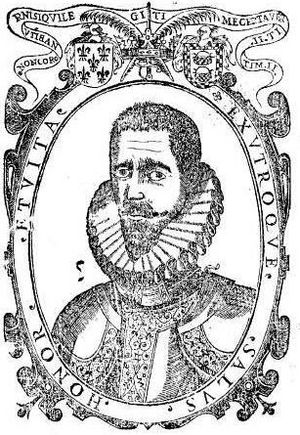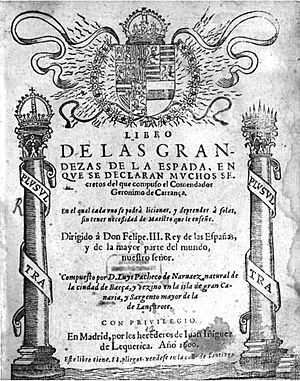Luis Pacheco de Narváez facts for kids
Quick facts for kids
Luis Pacheco de Narváez
|
|
|---|---|

Luis Pacheco de Narváez
|
|
| Born | 1570 |
| Died | 1640 |
| Occupation | Writer, fencing master |
| Notable works | Libro de las grandezas de la espada |
Don Luis Pacheco de Narváez (1570–1640) was an important Spanish writer. He was an expert in destreza, which was the Spanish way of fencing.
He learned from Don Jerónimo Sánchez de Carranza, who was a very famous fencing master. At first, Pacheco de Narváez wrote books that were based on Carranza's ideas. Later, he developed his own unique style. He even became the fencing teacher for King Philip IV of Spain.
Contents
About Luis Pacheco de Narváez
Luis Pacheco de Narváez was born in the city of Baeza. He spent his life working with weapons. He became a sergeant major in the Canary Islands, especially on the islands of Fuerteventura and Lanzarote.
We know that his parents were Rodrigo Marin de Narváez and Magdalena Pacheco Cameras. He married Beatriz Fernandez de Cordoba. Her father was a secretary for the Royal court in the Canary Islands.
In 1608, Pacheco de Narváez had a fencing match with a writer named Francisco de Quevedo. This happened because Quevedo had criticized one of Pacheco's books. During their fight, Quevedo managed to knock off Pacheco's hat very quickly.
Later, Quevedo made fun of this duel in his book El Buscón. In the story, a fencer who relied on math had to run away from a fight with an experienced soldier.
Life as a Swordsman
It's hard to find exact details about the lives of many medieval fencing masters, including Pacheco de Narváez. But we do know that being a fencing master in Spain during the 15th and 16th centuries was a very serious job. It needed a lot of training, great physical strength, and good organization. Only certain people were allowed to teach fencing and give out the title of master.
I was born with an innate fighting bias, just put my feet on the threshold of life and new forces, hit my ears in the ears and a special surprise was caused by the book Carranza.
—Luis Pacheco de Narvaez
Don Jerónimo Sánchez de Carranza was a key figure in Spanish fencing. He started the Spanish school of fencing called destreza. Carranza wrote a famous book called La filosofía de las armas y de su destreza, y de la agresión y defensa cristiana. This book was published in 1582. Carranza became Pacheco de Narváez's mentor and fencing teacher.
Pacheco de Narváez was also a military man. He served in the army and navy. He held different ranks like soldier, sergeant, ensign, sergeant major, and even governor.
Libro de las grandezas de la espada
Pacheco de Narváez's book, Libro de las grandezas de la espada ('Book of the Greatness of the Sword'), was very important. It became the main source for all Spanish fencing books in the 1600s. The first version of this book included all the ideas that Narváez learned from Carranza. This book shares many secrets, rules, and tips. It was written so that anyone could learn and teach fencing without needing other masters.
The book was written in Seville and was dedicated to King Philip III. As Carranza's student, Pacheco de Narváez carefully explained his teacher's methods. He also showed interesting diagrams with circles and sword positions. These diagrams showed how swords should be held and moved for different attacks.
The book also talked about why self-defense is important, based on human and religious laws. It explained how mastering weapons could help a person improve themselves. Pacheco de Narváez shared his knowledge and experience in the art of fencing.
In the mid-1500s, the Spanish fencing style had a special stance. The body was straight, but the heart was not directly in front of the opponent's sword. The right arm was straight, and the legs were not too far apart. This stance gave three benefits: the sword point was close to the enemy, the fencer had more strength, and it reduced the risk of elbow injury. The goal was not to cross swords with the enemy.
To help fencers understand the right distance, Carranza and Narváez used a circle drawn on the ground. They called it "circonferencia imaginata entre los cuerpos contrarios", which means 'imaginary circle around the opposing bodies'. This circle helped to plan actions during a fight.
Carranza focused mostly on cutting attacks, but he also used stabbing attacks. He explained how to do the first strike clearly. Narváez also wrote about thrusting (stabbing) attacks, but he didn't explain them in as much detail.
Modo fácil y nuevo para examinarse los maestros en la destreza de las armas
Another famous book by Pacheco de Narváez is Modo fácil y nuevo para examinarse los maestros en la destreza de las armas. This means 'A simple and new way for teachers to be examined in the art of fencing with weapons'. It is written as a conversation between a student and an examiner about fencing and its philosophy.
No one was allowed to print this book without special permission. It was published in Madrid on February 26, 1625.
This treatise (a detailed written work) explains how a student could become a maestro (master) in fencing. Pacheco de Narváez presented one hundred ideas or ways of thinking in this book.
The king was very pleased with Pacheco de Narváez's work. He made him the official examiner for all fencing teachers. However, it seems that other fencing teachers did not want to be examined by him. Records show that they united against him. For example, a document from the Supreme Court says:
Teachers of martial arts are suing Don Luis Pacheco de Narvaez, who must take the exam from all teachers.
—Luis Pacheco de Narváez, Letter L, file 4, 732
The book also talks about important rules for fencing that follow ideas of justice and peace. It says that a brave knight should be given a crown to show their wisdom and skill. The book describes how to train with weapons. It also mentions that talented students should get scholarships to help them study. It teaches that we should welcome those who want to learn, even if they are motivated by wanting an award. Ignoring someone is not a big mistake, but ignoring what is important is disrespectful to yourself. Pacheco de Narváez believed that a lack of talent or courage can stop someone from reaching their goals.
This book is very helpful for understanding the history of fencing. Experts consider it very valuable. It helped to bring back the art of fencing and showed what it was like during that time.
See also
 In Spanish: Luis Pacheco de Narváez para niños
In Spanish: Luis Pacheco de Narváez para niños
- Gérard (or Girard) Thibault of Antwerp
- La Verdadera Destreza



